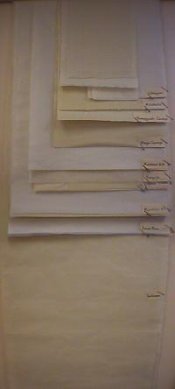Film Washi , Washi Traditional Japanese Papers and Use of Them
Digital Printing on Washi
More and more artists are turning to digital printing as a part of their production, and so are looking
for more interesting surfaces to print on than the standard digital papers available. Washi can be that
surface. The subtle liveliness of the fibre shows through the ink with softer results, and because washi
is generally more absorbent than western papers the paper and ink appear integrated rather than the
ink sitting on the surface. Since most types of Japanese paper are not specifically made for digital
print it is imperative that you test the paper you would like to use on the printer you will be using for
your project. What follows are some things to consider:
TIPS & THINGS TO CONSIDER
• papers with a smooth, non-fluffy surface will work best to avoid clogged ink nozzles
• kozo papers will generally produce softer-looking images
• for most detailed images gampi papers are ideal because of their inherently crisp surface
and 'non-bleeding' quality
• colours will appear less intense on thinner papers as there is less fibre to reflect light:
great for ethereal effects
• if you want to try very thin papers they should be printed with a heavier backing paper,
gently taped down with removable tape (backing absorbs bleed-through and also
prevents paper jams)
• try coating papers with a light gelatin sizing or inkAid if they are too absorbent
PAPER SUGGESTIONS
• Gampi Torinoko, a popular high quality opaque sheet gives consistently excellent results
• Gampi Smooth is a thinner, more translucent and very economical paper with good
results
• sized kozo papers such as Kizuki Kozo Natural & White (handmade, best quality) or
Kozuke White & Ivory (machine-made, economical) offer good results (Kozuke White is
available in roll format)
• Gozen is a handmade paper which is very lightly sized and works well
REFERENCES
inkAid coatings,
www.inkaid1.com
Painters and Drawers
Back to top
Kozo papers with extra weight like seichosen or Kurotani #4 are useable with all water-based media as long as the artist does not use heavy washes. Most Japanese paper shrinks somewhat when wet, though some are sized to prevent shrinkage. Acrylic paint and gouache are both very effective on washi. Oil paints are not recommended. It's best to keep your brush and paint on the dry side.
For drawing, all Japanese papers are possible, depending on the media used. Conte, soft charcoal, graphite (softer leads) and coloured pencils are all suitable on kozo papers. Gampi papers have a natural sizing which makes them good for pen and ink, and the sheen of the paper makes a beautiful ground for drawing. Pastels need a paper with some tooth like Moriki kozo or any Kurotani paper.
Drawing and painting are usually most effective if some of the beautiful surface of the paper itself is left to breathe or speak and is not completely filled in.
Printmakers
Back to top
Printmakers can get a range of unique effects with Japanese paper, and if the paper is made the traditional way, any printmaking technique can work with almost any paper.
100% kozo papers - Handmade excellently prepared kozo papers without chlorine bleaching such as Hosokawa, Seichosen and papers from Kurotani, are the hardiest and are great for woodblock printing, monoprints and linocuts. Thin kozo papers are good for chine-collé. They have good absorbency even when very thin because the careful preparation of the fibre creates an even receptivity to ink and moisture. Their great wet strength makes them also appropriate for etching, though they are better misted rather than soaked. The fine texture of a well-made sheet of kozo means that it is used more effectively when there are areas of the paper left unprinted to go hand-in-hand with the artist's work.
100% mitsumata - Mitsumata paper often has a more creamy tone than kozo, has a shorter fibre than kozo which makes it not quite as strong, and is even more absorbent than its hardier cousin. It is especially good for relief prints especially when the artist wants soft edges on printed areas rather than very clear definition. Seikosen, Mitsumata Tissue and Izumo dyed papers are some of the papers we carry made from mitsumata.
100% gampi paper favoured by Rembrandt for his etchings, gampi papers hold the inked line with amazing delicacy yet depth. If clarity of image is desired, this fibre is the one to choose. Gampi tends to shrink when it is wet, so it can be tricky to use for chine-collé. To get around this problem a paper called gampi-etching was developed with a thin layer of gampi on top of a much heavier cotton and sulphite base. Thinner versions of gampi are wonderful for lithography as the sleekness of the surface prevents the fibre pulling off onto the roller and we have a wide range of weights of gampi












